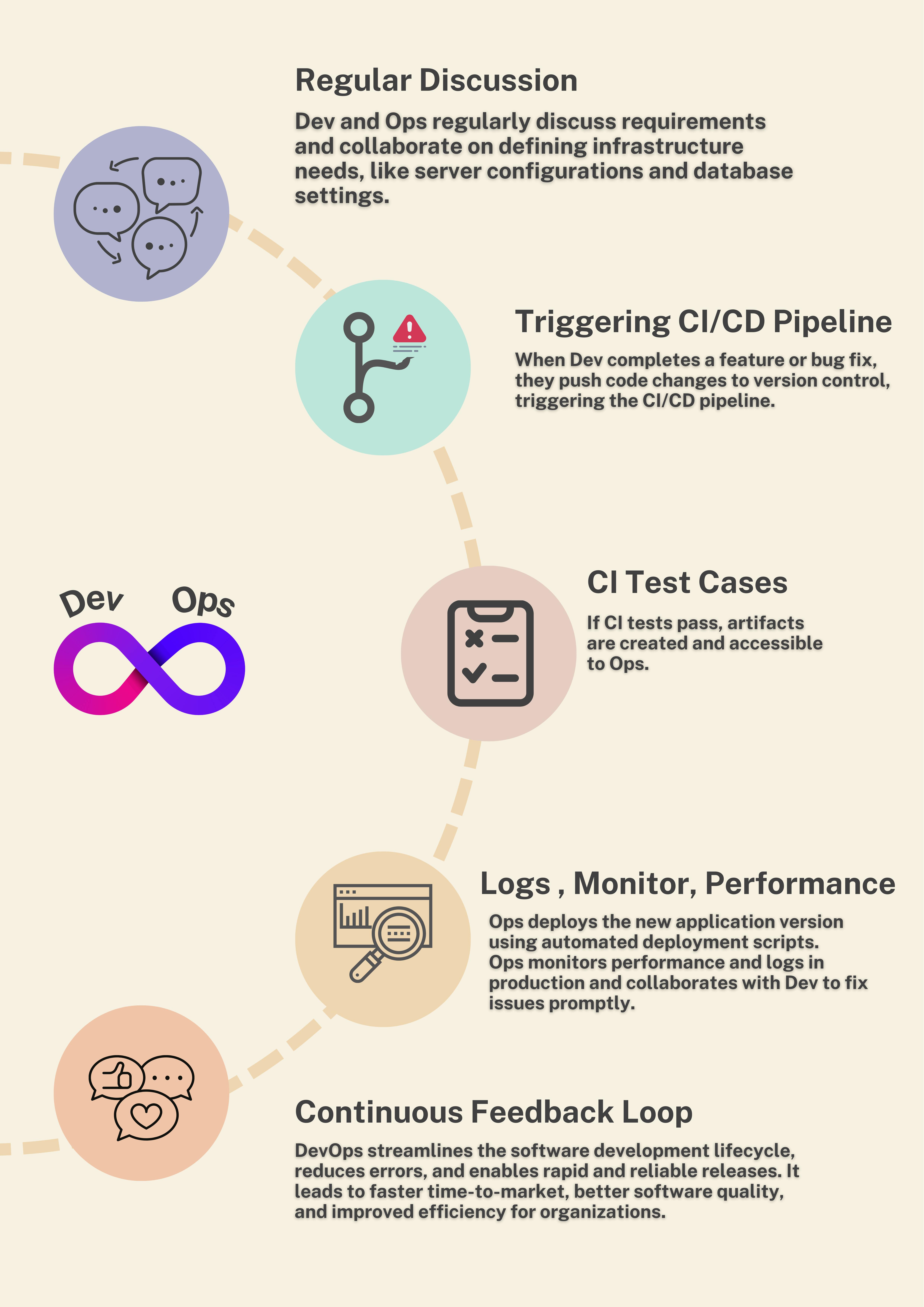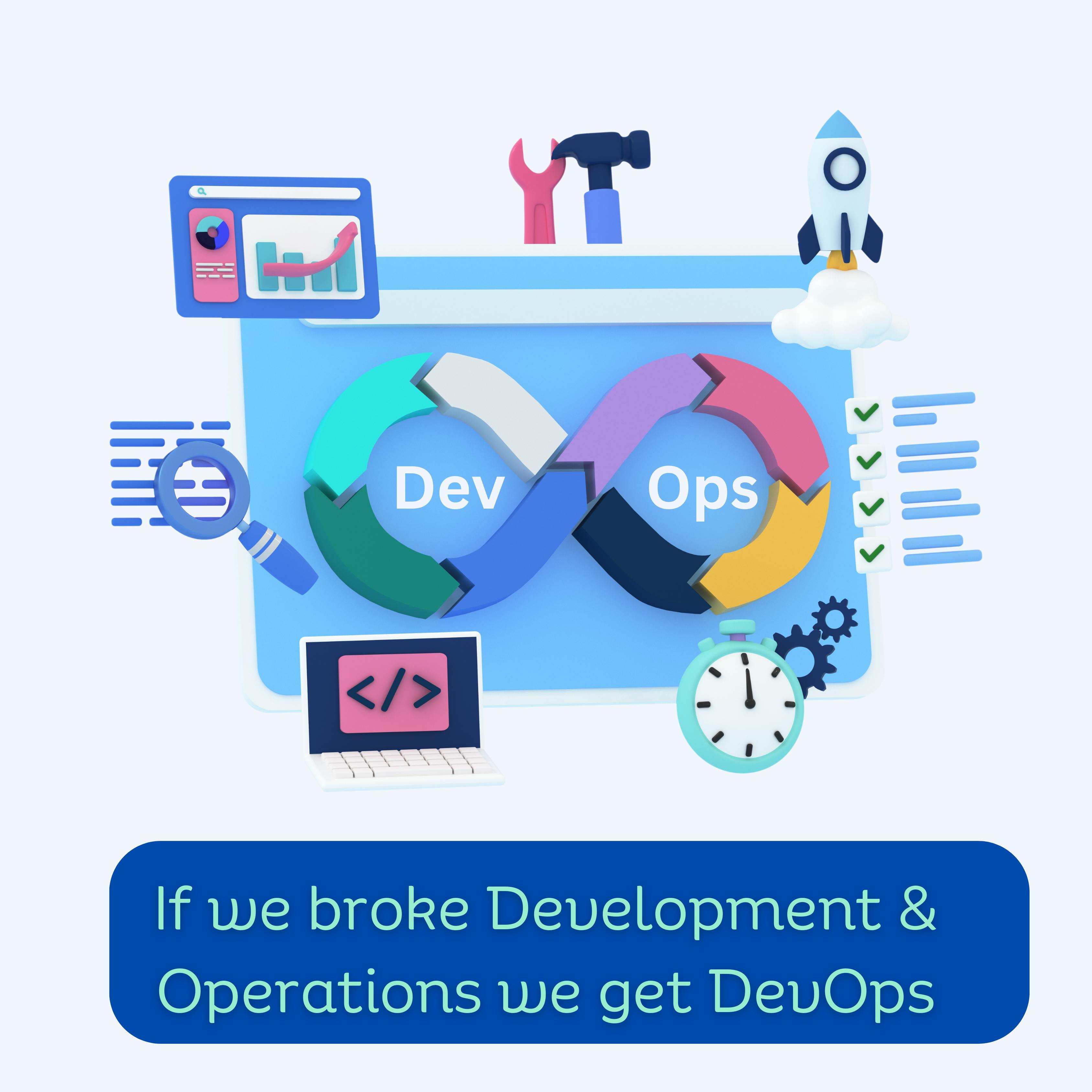Mastering the Modern Workflow: An Introductory Dive in the World of DevOps
Day 1: Kickstarting 90 Days of DevOps
Introduction
Welcome to the start of an exciting 90-day DevOps journey! In this blog post series, we'll delve into the world of DevOps, its core principles, and how it plays a pivotal role in modern software development. Whether you're a seasoned developer looking to enhance your skills or someone new to the DevOps landscape, this journey promises valuable insights and practical knowledge.
Significance of DevOps in Modern Software Development
DevOps, a portmanteau of "Development" and "Operations," is a set of practices, principles, and cultural philosophies that aim to streamline and automate the software development and deployment process. It emphasizes collaboration and communication between development and operations teams to deliver high-quality software more quickly and efficiently. Here's a simplified example of how Dev and Ops individuals might work together in a DevOps context:
Scenario: Imagine a software company that is developing and deploying a web application.
Dev (Developer):
Code Development: Devs write the application code, working closely with product managers and designers to understand requirements. They use tools like Git to manage their code changes.
Continuous Integration (CI): Devs set up a CI/CD pipeline, creating automated tests to check the code's functionality. These tests run automatically when new code is committed to catch issues early.
Artifact Generation: After successful CI tests, Devs create deployable artifacts (e.g., Docker containers, executables) stored in a repository for Ops to access.
Ops (Operations):
Infrastructure as Code (IaC): Ops defines the required infrastructure (servers, databases, etc.) using tools like Terraform or Ansible.
Provisioning and Scaling: Ops automatically provisions resources based on the defined infrastructure code and can scale resources as needed.
Deployment Automation: Ops automates deployment scripts to deploy artifacts provided by Dev to the production environment, ensuring consistency and rollback capabilities.
Monitoring and Logging: Ops sets up monitoring tools to track application performance and centralized logging for gathering information about application behavior.
Collaboration Senario:

What is DevOps ?
DevOps is a software development approach that combines development (Dev) and operations (Ops) teams to streamline and automate the entire software delivery process, promoting collaboration and faster, more reliable releases.
Formal Defination: DevOps is the union of people, process, and products to enable continuous delivery of value to our end users.

What are the terminologies and concepts associated with DevOps ?
It's a broad and evolving field with many associated terminologies and concepts. Here are some of the key ones:
Continuous Integration (CI): CI is the practice of regularly merging code changes into a shared repository. Automated builds and tests are typically run to ensure that new code integrates well with existing code.
Continuous Deployment (CD): CD extends CI by automatically deploying code changes to production or staging environments after passing CI tests. It helps in achieving a rapid and reliable release process.
Automation: DevOps emphasizes the automation of repetitive tasks, such as infrastructure provisioning, software deployment, and testing. Tools like Ansible, Puppet, and Terraform are commonly used for this purpose.
Infrastructure as Code (IaC): IaC is the practice of defining and managing infrastructure (servers, networks, and other resources) using code. This enables consistent, repeatable, and version-controlled infrastructure provisioning.
Version Control: Version control systems (e.g., Git) are essential for tracking changes to code and configuration files, enabling collaboration, and facilitating the rollback of changes when needed.
Containers and Orchestration: Containers (e.g., Docker) package applications and their dependencies into portable units. Container orchestration tools (e.g., Kubernetes) manage the deployment and scaling of containers.
Microservices: Microservices architecture breaks down applications into smaller, independently deployable services. DevOps practices are well-suited for managing microservices.
Monitoring and Logging: Continuous monitoring and logging of applications and infrastructure help identify issues, track performance, and troubleshoot problems quickly. Tools like Prometheus and ELK Stack are common choices.
Collaboration and Communication: Effective communication and collaboration between development and operations teams are central to DevOps. Tools like Slack, Microsoft Teams, and Jira facilitate this collaboration.
DevOps Culture: DevOps is not just about tools and automation; it's also a cultural shift. It promotes collaboration, shared responsibility, and a focus on delivering value to customers quickly and consistently.
CI/CD Pipeline: A CI/CD pipeline is a series of automated steps that code goes through, from development to production. It includes building, testing, and deploying code changes.
Versioning: Versioning is crucial for both code and infrastructure. Semantic versioning (e.g., MAJOR.MINOR.PATCH) helps manage and communicate changes effectively.
Immutable Infrastructure: In an immutable infrastructure, servers and components are never modified after deployment. Instead, when changes are needed, new instances are created with the desired configuration.
Blue-Green Deployment: This deployment strategy involves running two separate environments (blue and green), where one is active (blue) while the other is a clone (green). When deploying updates, traffic is switched from one environment to the other, allowing for easy rollbacks.
Configuration Management: Tools like Ansible, Chef, and Puppet help manage and automate the configuration of servers and applications, ensuring consistency and reproducibility.
Scalability and Elasticity: DevOps practices often involve designing systems that can scale horizontally to handle increased load and scale back down when demand decreases (elasticity).
Security as Code: Security is integrated into the development process through practices like static code analysis, vulnerability scanning, and automated security testing.
DevSecOps: This extends DevOps to include security practices, emphasizing the integration of security into the entire software development lifecycle.
Feedback Loops: DevOps encourages feedback loops at every stage of the development process, helping teams learn from failures and continuously improve.
Site Reliability Engineering (SRE): SRE is a discipline that combines aspects of software engineering and applies them to infrastructure and operations problems. It aims to create highly reliable and scalable software systems.
These are just some of the many terms and concepts associated with DevOps. DevOps is a dynamic field that evolves with technological advancements and organizational needs, so staying current with new trends and tools is essential for practitioners.
Why DevOps is Important ?
DevOps is important for a variety of reasons:
Faster Time to Market: DevOps practices help organizations release software updates and new features more quickly and efficiently. This accelerated time to market can be a significant competitive advantage, enabling companies to respond to customer needs and market changes faster.
Improved Collaboration: DevOps fosters collaboration between development and operations teams, breaking down traditional silos. This collaboration leads to better communication, shared responsibilities, and a deeper understanding of each other's roles and challenges.
Enhanced Quality and Reliability: By automating testing, deployment, and monitoring processes, DevOps reduces the risk of human error and ensures a more consistent and reliable software release process. This results in higher-quality software with fewer defects.
Continuous Integration and Continuous Delivery (CI/CD): DevOps promotes the adoption of CI/CD pipelines, which automate the building, testing, and deployment of software. CI/CD pipelines enable developers to integrate code changes more frequently, leading to smaller and more manageable updates.
Improved Efficiency and Resource Utilization: Automation of repetitive tasks and processes allows organizations to make more efficient use of resources. This can lead to cost savings and a more efficient allocation of development and operations teams' time and skills.
Scalability and Flexibility: DevOps practices make it easier to scale infrastructure and applications as needed. This scalability is essential for businesses experiencing growth or dealing with fluctuating workloads.
Enhanced Security: While security is a shared responsibility, DevOps encourages the integration of security practices throughout the development process (DevSecOps). This helps identify and address security vulnerabilities earlier in the software development lifecycle.
Better Feedback Loops: DevOps encourages the gathering of feedback from users and operations teams, enabling developers to make improvements based on real-world usage and operational insights.
Regulatory Compliance: Automation and documentation in DevOps practices can help organizations meet regulatory and compliance requirements more easily, as it provides a transparent and auditable development and deployment process.
Cultural Transformation: DevOps often leads to a cultural shift within organizations, fostering a mindset of continuous improvement, learning, and innovation. This cultural transformation can have a positive impact on employee morale and retention.
Customer Satisfaction: By delivering features and fixes faster, with higher quality and reliability, DevOps can lead to increased customer satisfaction. Satisfied customers are more likely to remain loyal and recommend the company's products or services.
In general, DevOps is important because it enables organizations to be more agile, efficient, and responsive to market demands while maintaining or even improving the quality and security of their software products. It's not just a set of tools and practices but a cultural and organizational shift that can deliver significant business benefits.
CONCLUSION
In conclusion, as we embark on this 90-day DevOps journey, we've gained a fundamental understanding of its significance in modern software development. DevOps is more than just a combination of development and operations; it's a cultural shift that accelerates time to market, improves collaboration, enhances quality and reliability, and brings efficiency and scalability to organizations. This holistic approach, encompassing automation, continuous integration, security, and cultural transformation, empowers companies to meet customer needs faster and deliver higher-quality software while staying competitive in today's dynamic market. Stay tuned for the upcoming insights and practical knowledge throughout this exciting journey into the world of DevOps.
Glimpse of Day 2 - The journey has just begun. Before we delve into the beginning, let's discuss a few more questions. For example, how does one become a DevOps engineer? What knowledge is required to embark on this career path? Finally, let's start by learning the basics of Linux commands.


